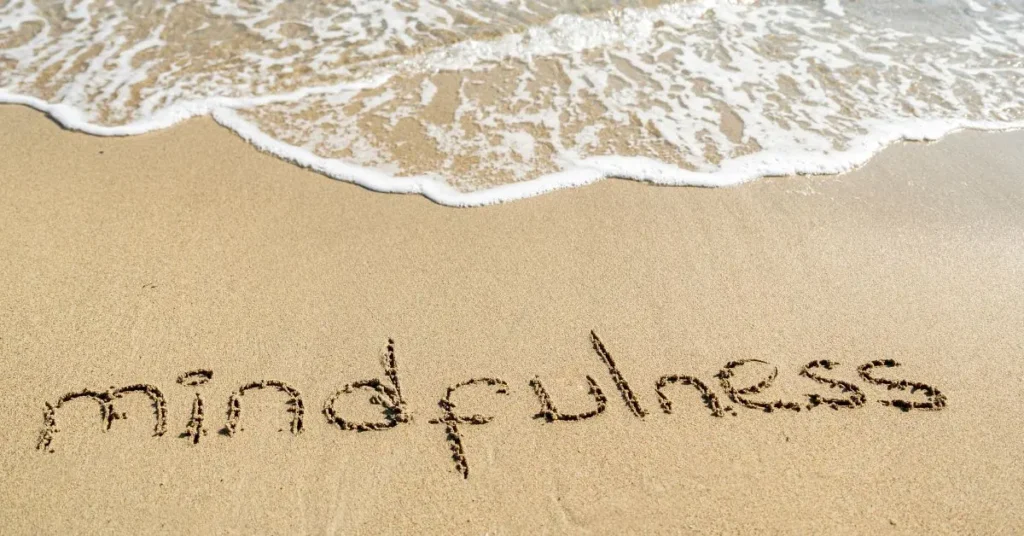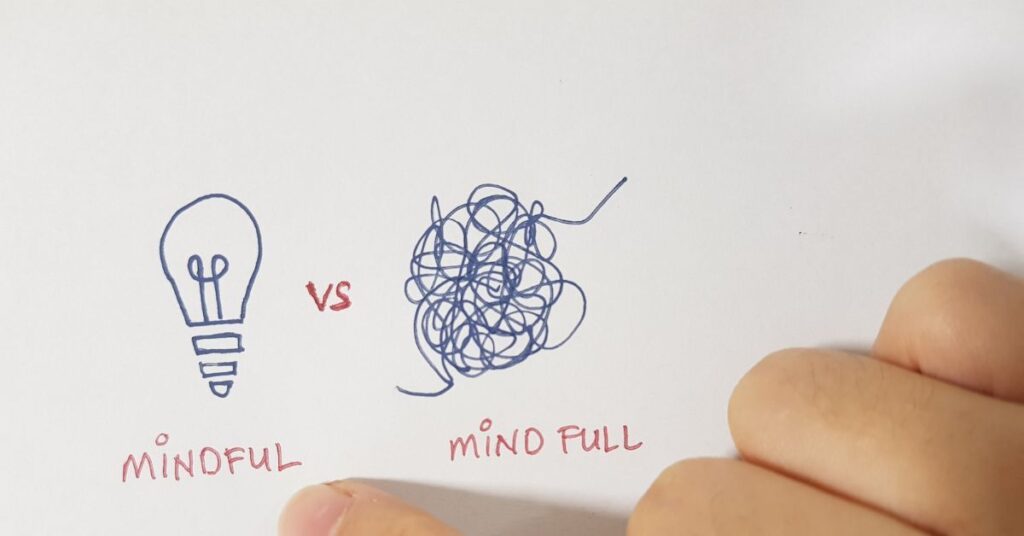Does your mind feel like it’s everywhere at once? Planning for tomorrow, replaying yesterday, creating endless to-do lists, but rarely just… here? If so, you’re part of the vast majority of humanity experiencing the modern condition of mental overwhelm.
We live in a world that constantly pulls us away from ourselves. In this whirlwind, one practice has emerged as a powerful antidote: mindfulness. But what does it really mean, and how can it transform your daily experience?
Unlike what many believe, mindfulness isn’t a complicated meditation technique reserved for monks on distant mountains. It’s a natural human ability accessible to everyone: the capacity to pay attention, on purpose, to the present moment, without judgment.
It’s the art of awakening to your own life. This comprehensive guide will unveil what mindfulness truly is and show you practical ways to bring more presence, calm, and clarity into your everyday routine.
Table of Contents

Mindfulness Is More Than (Just) Meditation
This is the first and most crucial myth to dispel. Many people associate mindfulness with having to sit cross-legged and “empty the mind,” which seems impossible and often leads to frustration.
Think of it this way:
- Meditation is the training—like going to the gym to strengthen your attention “muscle.”
- Mindfulness is the practice in daily life—using that strengthened muscle while you work, eat, converse, or walk.
The goal isn’t to stop thoughts but to change your relationship with them. Instead of being swept away by the current of worries, you learn to sit on the riverbank and simply observe thoughts passing like clouds in the sky. You transform from having a “mind full” to being “mindful.”
The Three Pillars of Mindful Awareness
Mindfulness practice rests on three fundamental attitudes that we cultivate intentionally:
1. Intention
This is the deliberate choice to pay attention. Instead of living on autopilot, you consciously decide to bring your awareness to the present moment.
2. Present-Moment Attention
Your consciousness focuses on your current experience. This might be the sensation of air flowing in and out of your lungs, the taste of your food, sounds around you, or sensations in your body.
3. Non-Judgmental Attitude
Perhaps the most transformative pillar. You observe your thoughts, feelings, and sensations exactly as they are—without criticizing yourself, without trying to change them, and without clinging to them. You adopt a stance of curiosity and gentleness toward yourself.
Evidence-Based Benefits of Mindfulness Practice
Scientific research consistently demonstrates that mindfulness practice offers profound benefits for both mental and physical health:
Mental Health Benefits
- Significant reduction in stress and anxiety – Studies show mindfulness can reduce anxiety by up to 12.6% compared to control groups
- Improved focus, concentration, and memory – Regular practice enhances cognitive function and attention span
- Better emotional regulation – Mindfulness increases emotional intelligence and helps manage difficult emotions more effectively
- Enhanced mood and well-being – Research indicates a 6.9% improvement in overall well-being after just 30 days of practice
- Reduced depression symptoms – Studies show a 19.2% reduction in depression scores compared to control groups
Physical Health Benefits
- Lower stress hormones – Mindfulness reduces cortisol levels, the primary stress hormone
- Improved sleep quality – Regular practice promotes better sleep patterns and rest
- Enhanced pain management – Mindfulness meditation significantly reduces both pain intensity and unpleasantness
- Better immune function – Practice supports overall physical health and resilience
Neurological Changes
Research using advanced brain imaging shows that mindfulness practice creates measurable changes in brain structure:
- Increased cortical thickness in areas related to emotional processing and sensory perception
- Reduced amygdala reactivity, leading to decreased stress responses
- Enhanced connectivity between brain regions involved in attention and self-regulation

How to Practice Mindfulness in Daily Life (Without Sitting on a Cushion)
The beauty of mindfulness lies in its integration into every moment of your life. Here are evidence-based practices you can start today:
The One-Minute Reset
Wherever you are—at work, in traffic, in the grocery line—take a pause. Stop everything. Feel your feet on the ground. Now, give your complete attention to three full breaths. Feel the air entering, filling your lungs, then slowly exiting. That’s all. It’s an instant “reset” for an overloaded nervous system.
Mindful Eating
During your next meal, dedicate the first few minutes to eating in silence. Before taking your first bite, observe the colors and textures on your plate. Notice the aroma. As you chew, do so slowly, paying attention to flavors and the sensation of food in your mouth. This practice transforms eating and can even improve digestion.
Active Listening
In your next conversation, experiment with listening with 100% of your attention. Instead of planning what you’ll say next, simply listen. Hear the words, tone of voice, and pauses. Offering your complete presence to another person is one of the greatest gifts you can give.
Mindful Walking
While walking, even from your car to your front door, bring attention to physical sensations. Feel the contact of your feet with the ground, the swing of your arms, the breeze on your face. Observe the world around you as if seeing it for the first time.

Household Tasks as Meditation
Routine activities are golden opportunities for mindfulness. While washing dishes, feel the water temperature on your hands, smell the soap, hear the sound of water. When folding laundry, feel the texture of fabric. You can find peace in the most unexpected places.
Workplace Mindfulness
Modern research shows that workplace mindfulness significantly reduces job stress and improves performance:
- Morning intention setting – Begin each workday with two minutes of mindful breathing
- Conscious transitions – Take three breaths between meetings or tasks
- Mindful breaks – Step away from your desk for brief awareness practices
- Email mindfulness – Read and respond to messages with full attention rather than rushing
Breathing Techniques for Beginners
Start with these simple, scientifically-backed breathing practices:
- Box breathing: Inhale for 4 counts, hold for 4, exhale for 4, hold empty for 4
- Natural breath observation: Simply notice your breathing without trying to change it
- Breath counting: Count each exhale from 1 to 5, then start over
Getting Started: A Practical Approach
Research shows that consistency matters more than duration. Even 10 minutes of daily practice can produce significant improvements in well-being, anxiety, and depression. Here’s how to begin:
Week 1: Foundation Building
- Choose one simple practice (like mindful breathing)
- Practice for just 2-3 minutes daily
- Set a consistent time (morning works well for most people)
- Use a timer or mindfulness app for guidance
Week 2-4: Expanding Awareness
- Gradually increase practice time to 5-10 minutes
- Add mindful moments to daily activities
- Notice without judgment when your mind wanders—this is normal and part of the practice
Beyond the First Month
- Explore different techniques to find what resonates
- Join a mindfulness group or class for support
- Remember that mindfulness is a lifelong journey, not a destination
Common Misconceptions and How to Overcome Them
“I’m Too Busy for Mindfulness”
Mindfulness doesn’t require extra time—it’s about bringing quality attention to activities you’re already doing. Even 30 seconds of mindful breathing can make a difference.
“My Mind Won’t Stop Thinking”
The goal isn’t to stop thoughts but to change your relationship with them. Noticing that your mind has wandered and gently returning attention to the present is exactly what mindfulness practice involves.
“I Need Perfect Conditions”
While quiet environments can be helpful, mindfulness can be practiced anywhere—in busy offices, crowded buses, or noisy households. The practice is about working with whatever conditions exist.
The Science of Sustainable Practice
Research indicates that the benefits of mindfulness compound over time. Studies show that participants who maintain regular practice for 8 weeks experience:
- Structural brain changes in areas associated with learning and memory
- Improved stress resilience lasting months after initial training
- Enhanced emotional regulation affecting relationships and work performance
The key is starting small and building gradually. Even brief, consistent practice creates lasting positive changes in both brain structure and daily experience.

Making Mindfulness Your Own
Mindfulness isn’t about adding another task to your to-do list—it’s about bringing a new quality of attention to tasks you already perform. It’s not about emptying your mind but being fully conscious of what’s in it, with an attitude of gentleness and curiosity.
Begin where you are, with what you have. Start small and embrace imperfection. The goal isn’t performance but connection—to yourself, to others, and to the richness of each present moment.
Remember, mindfulness is both remarkably simple and profoundly transformative. In a world that constantly demands your attention, choosing to be present is both an act of self-care and quiet rebellion. Every moment offers a fresh opportunity to wake up to your life.
The question isn’t whether you have time for mindfulness—it’s whether you can afford not to cultivate this essential life skill. Your future self will thank you for starting today.
Enjoyed this content? Read more on our website.
REFERENCES
AMERICAN PSYCHOLOGICAL ASSOCIATION (APA). Mindfulness. https://www.apa.org/topics/mindfulness.
Ready to begin your mindfulness journey? Start with just one practice from this guide and commit to it for a week. Notice what changes, both subtle and significant, as you bring more presence to your daily life.
